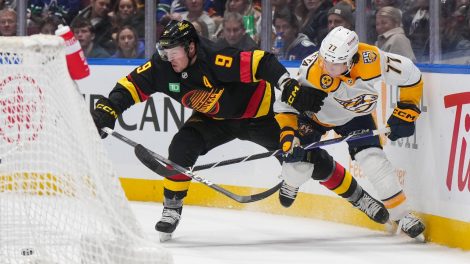There are three main goaltending styles in today’s NHL. Each are effective, and some work better than others depending on the individual. Here’s a look at all three, who uses them, who teaches them and what the advantages and disadvantages are for each.
Butterfly Hybrid
The Butterfly first came into play in the late 1960s with Tony Esposito, but the style has since evolved with equipment becoming more protective. The Butterfly Hybrid style really took on a life of its own with Patrick Roy in the mid-80s. Francois Allaire, Roy’s longtime goalie coach, had a theory that 75 per cent of shots are on the ice and that it was harder for a shooter to score by having to lift the puck.
When Roy won the Stanley Cup in 1986 with Montreal, the Hybrid suddenly became all the rage with French goaltenders.
The Butterfly Hybrid is a mix between a Stand-Up and a Butterfly. On high shots a Hybrid goalie may choose to stay on their feet, but when anything is shot along the ice, they will drop into Butterfly.
Pros: Typically, Hybrids are very patient goalies with a calm, cool demeanour. They wait for the shooter to make the first move and are rarely caught out of position.
Cons: These goaltenders sometimes get caught being too patient and get scored on standing still with their feet frozen in position.
Current Butterfly Hybrid goalies:
Carey Price
Jonathan Bernier
Tuukka Rask
Devan Dubnyk
Coaches who teach this style:
Mitch Korn – Washington Capitals
Dwayne Roloson – Anaheim Ducks
Bob Essensa – Boston Bruins
Athletic Butterfly
The Athletic Butterfly first came into prominence during the 1970s with former Toronto Maple Leaf Mike Palmateer. Back then, who didn’t pretend they were Palmateer on a Saturday night watching Hockey Night in Canada? Later, the Finns started to develop this style during the late-1990s as they felt great goaltending was the only way they could compete with hockey’s most powerful nations.
They developed a system that relied on size, athleticism, and trying to catch as many pucks as possible in order to keep possession. These goalies can be very acrobatic, and are typically hard workers. They use their athleticism and most saves are spectacular.
Pros: Never out of a save, and what seems like a sure goal can be thwarted by an athletic effort. Shooters never know what these unpredictable goalies will do.
Cons: This style of goaltender can be inconsistent and can get himself out of position.
Current Athletic Butterfly goalies:
Jonathan Quick
Ryan Miller
Pekka Rinne
Craig Anderson
Sergei Bobrovsky
Coaches who teach this style:
Bill Ranford – Los Angeles Kings
Rick Wamsley – Ottawa Senators
Kim Dillabaugh – Philadelphia Flyers
Blocking Style
This style arrived when Allaire, in the early-2000s, took Jean-Sebastian Giguere of the Anaheim Ducks and adapted the Butterfly Hybrid he originally created. Allaire turned it into a style in which there would be very little chance for error, and even the least athletic goalies could successfully employ. It is all about using the centre of the body as the biggest blocking area and covering the ice at all times.
These goalies presume that 75 per cent of shots are on the ice. They believe their bodies are the largest area to be hit by a puck, and try to use it to make every save. Every save is a Butterfly save.
Pros: Players must shoot around them to score, and nothing goes through them. They’re almost always in good position. Skaters have to shoot high to score and rarely do these goalies get beat along the ice.
Cons: Not much athleticism is required, making these goaltenders robotic at times. Their hands drop to their sides to create a larger surface area to hit and they tend to limit their movement. Typically, they don’t catch pucks, and are more apt to block them, even with their catcher.
Current Blocking Style Goalies
Corey Crawford
Jonas Hiller
Antti Niemi
Coaches who teach this style:
Francois Allaire – Colorado Avalanche
Stephane Waite – Montreal Canadiens
Rollie Melanson – Vancouver Canucks
Personally, I was taught by Bob Froese to be a Stand-Up goaltender early in my career, and I was very good at it. However, when the Butterfly Hybrid took over in the early-1990s, I felt unable to keep up. I felt I was always one goal against behind.
Fortunately, in the late-’90s I signed with Nashville and met Mitch Korn. He told me that if I didn’t change, I would be out of the game quickly. Based on his advice, I changed my style and squeezed in another seven years as a pro – albeit not in the NHL, but still professionally.
The goalies who were too old to change were out of the game quickly once the Hybrid took over. Some of these goalies included Bill Ranford, Kirk McLean, and Mike Vernon. They had great careers and were amazing goaltenders, but the arrival of the Hybrid may have ended their careers a bit prematurely.








